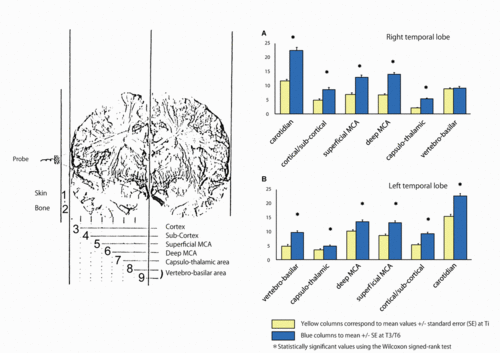News&Topics
Research
2018/04/10ResearchResearch Results
Research Paper Published on "Electromagnetic Field Intolerance Syndrome (EMFIS)", which has no recognized treatment, with Reference to Improvement of Clinical Outcomes and Normalization of Decreased Cerebral Blood Flow with FPP Treatment
New paper has been published on FPP.
Prof. Dominique Belpomme of Paris V University Hospital, France reported that in his clinical trial using FPP for "electro hypersensitivity" self-reporting patients , clinical improvement was obtained in 50-60% of the cases, among which 20-35% presented major improvement that mainly consisted of the regression of cognitive symptoms such as loss of short term memory, concentration, attention deficiencies, insomnia, and fatigue, and moreover, this clinical improvement was objectively supported by blood tests and measurement of mean PI in the temporal lobes by using UCTS in Functional Foods in Health and Disease Vol.8, No.2(2018) published on February 28, 2018.
【FIG1】Mean PI values recorded by UCTS in the different territories of each temporal lobe investigated at T3/T6
※Click here to enlarge the image.
Recently, we have so many electronic devices in our daily lives and cannot do without them. While we are exposed diversifying source of electrical wave or electromagnetic waves, there appear to be increasing number of people suffering from hyper sensitivity induced by electromagnetic waves or electromagnetic field, generally called "electromagnetic hypersensitivity". The symptoms are different, from moderate to severe, depending on each patient, and some patients are suffering from difficulties in their daily lives.
However, "Electromagnetic hypersensitivity [EHS]" has currently no clear diagnostic criteria and there is no scientific evidence to link EHS symptoms to electromagnetic waves. The WHO is firm in its position that to date there is no consistent research evidence to conclude that exposure to low level electromagnetic fields is harmful to human health.
While EHS is not recognized by the scientific medical community as a disease yet, the purported symptoms are real and it is necessary to establish diagnosis and treatment methods for those who suffer from EHS. Prof. Dominique Belpomme of University of Paris, France, published his clinical paper on his study using FPP on EHS self-reporting patients. Overall, clinical improvement was obtained in 50-60% of the cases, among which 20-35% presented major improvement that mainly consisted of the regression of cognitive symptoms such as loss of short term memory, concentration, attention deficiencies, insomnia, and fatigue. This clinical improvement was objectively supported by a statistically significant normal recovery of mean PI in the temporal lobes and by inflammation-related peripheral blood tests.
Fermented Papaya Preparation (FPP) has some antioxidant, anti-inflammation, and immuno-modulating properties. The objective of this clinical trial is test if FPP treatment can improve clinical outcomes, and can normalize biological abnormalities of EHS self-reporting patients, since they experience some degree of oxidative stress, inflammation, and autoimmune response.
32 subjects were treated with 9g of FPP a day (4.5g x2 /day) serially to evaluate FPP tolerance and clinical effects on EMFIS symptoms after 3 and 6 months. Clinical assessment was conducted by using a validated pre-established questionnaire. Biological assessment consisted of measuring intracerebral tissue pulsometric index (PI) in the temporal lobes with ultrasonic cerebral tomosphygmography (UCTS), in addition to oxidative stress and inflammation with a battery of oxidative stress and inflammation-related peripheral blood tests.
The clinical assessment showed that clinical improvement was obtained in 50-60% of the cases, among which 20-35% presented major improvement that mainly consisted of the regression of cognitive symptoms such as loss of short term memory, concentration, attention deficiencies, insomnia, and fatigue. (Table1)
 【Table1】Symptomatic evaluation at T3 and T6 in comparison to T0.
【Table1】Symptomatic evaluation at T3 and T6 in comparison to T0.
Also, the peripheral blood tests showed that for a group of EHS self-reporting patients with oxidative stress there was a statistically significant decrease of MDA level in the plasma and a statistically significant increase in the glutathione peroxidase activity in RBC.
Further, there is a statistically significant decrease in the number (and percentage) of EHS patients with abnormal inflammation-related biomarker values for histamine, S100B protein, and HSP27/70 chaperone proteins, suggesting the occurrence of some FPP-related anti-inflammatory effect in the peripheral blood of EHS patients with initially detectable inflammation. (Table2)
 【Table2】Mean values (+/- SD) of inflammation-related biomarkers at T3 and T6 in comparison with Ti
【Table2】Mean values (+/- SD) of inflammation-related biomarkers at T3 and T6 in comparison with Ti
It is noteworthy that observation of some clinical improvement was supported scientifically by biological assessment consisted of measuring intracerebral tissue pulsometric index (PI) in the temporal lobes, in addition to oxidative stress and inflammation-related peripheral blood tests. Low cerebral blood flow and disturbed circulation of oxygen and nutrients into the brain have been recognized as one of risk factors for cognitive dysfunction. Normalization of Decreased Cerebral Blood Flow of EHS patients in this study【FIG1】suggests that FPP has potential not only to improve Clinical Outcomes of EHS, but also to help to prevent dementia.
We will continue to conduct researches on FPP's clinical mechanism, hoping that we can contribute to establish treatment methods for environmental diseases such as "electro hypersensitivity" or "chemical hypersensitivity", as well as to put greater focus on researches for prevention of cognitive disorders in the aging society.
*Functional Foods in Health and Disease 2018; 8(2):122-144
Irigaray Philippe, Garrel Catherine, Houssay Carine, Mantello Pierre, Belpomme Dominique
Beneficial effects of a Fermented Papaya Preparation for the treatment of electrohypersensitivity self-reporting patients: results of a phase I-II clinical trial with special reference to cerebral pulsation measurement and oxidative stress analysis

